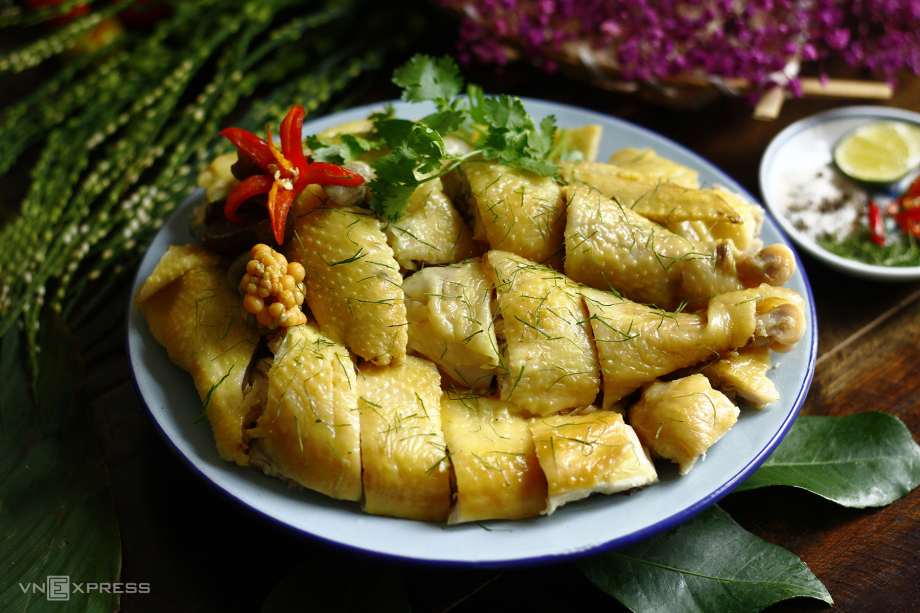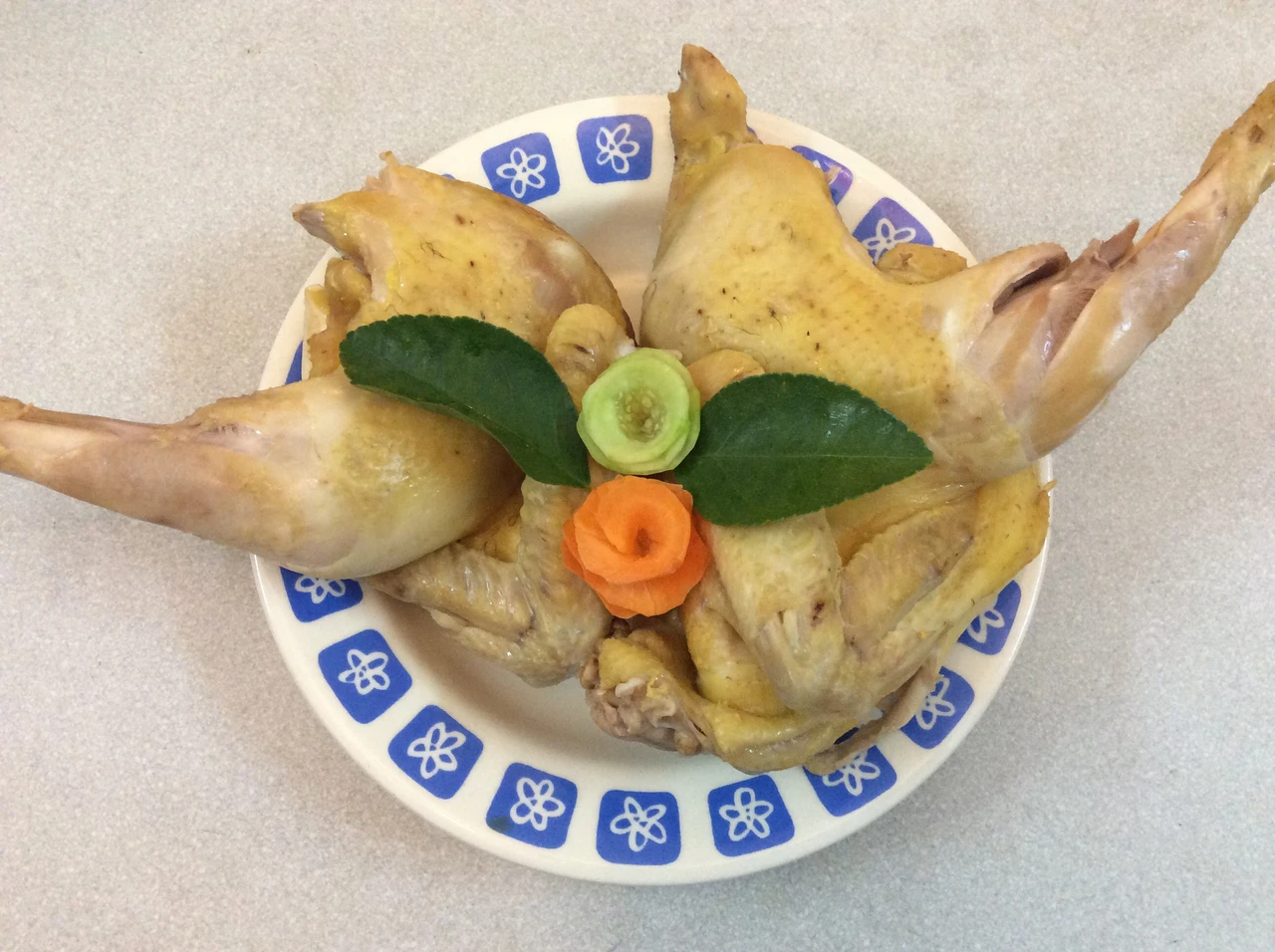Gà ta luộc lá chanh (Free-Range Boiled Chicken with Lime Leaves)

Ingredients
Main Protein
-
1.3kg whole chicken (cleaned, optional: tie or truss for even cooking)
Aromatics & Herbs
-
10 lime leaves (lá chanh – thinly sliced, some whole for boiling)
-
1 knob of ginger (crushed)
-
2 shallots (lightly smashed)
Seasonings
-
2 tbsp salt (used for both cleaning and seasoning the boil)
-
1 tsp ground pepper (for dipping or seasoning post-boil)
Optional serving suggestion:
-
Slice chicken and serve with dipping sauce of lime juice + salt + pepper + sliced lime leaf, or a mix of fermented soybean sauce + chili + ginger (tương bần gừng ớt).
Nutritional Information
For: Omnivores
Calories per serving: ~ 250–300 kcal (per 100g cooked chicken with skin)
Key Nutrients
1. Lean Protein (25–28g)
- Source: Whole chicken
- Benefits: Builds and repairs muscle, supports immune function, and keeps you full longer.
2. Healthy Fats (10–12g)
- Source: Chicken skin and fat
- Benefits: Provides energy, supports absorption of fat-soluble vitamins, and adds rich flavor (can reduce by removing skin).
3. Antioxidants & Anti-Inflammatory Compounds
- Gingerol (ginger): Supports digestion and reduces inflammation
- Quercetin (onion): May support immunity and heart health
- Essential oils (lime leaves): Aid digestion, freshen flavor, and have antimicrobial properties
4. Essential Minerals
- Iron & Zinc (chicken): Supports oxygen transport and immune health
- Potassium (chicken + herbs): Helps regulate muscle and nerve function
1. Prepare the chicken
Clean the chicken thoroughly. Pour boiling water over it to help remove any residual feathers and odor. Rub a thin layer of fish sauce onto the skin and let it sit for about 5 minutes to absorb the flavor before boiling—this helps make the skin more flavorful and crispy.

- Place the chicken in a pot of cold water with a small piece of crushed ginger and a teaspoon of salt.
- Bring to a boil, skim off any foam, then reduce the heat to low.
- Simmer for about 10 minutes, turn off the heat, and cover the pot for 3 minutes.
- Turn the heat back on, bring to a boil again for 3 minutes, then turn off the heat completely and let the pot sit on the stove for 2 more minutes.
- To check for doneness, pierce the chicken thigh with a skewer or chopstick—if no pink juice seeps out, the chicken is fully cooked.

3. Cool and serve
- Once cooked, transfer the chicken to a bowl of ice water. This helps firm up the meat, crisps the skin, and removes any leftover scum from boiling
- Let it drain, then chop into bite-sized pieces and arrange on a plate.
- Finely slice lime leaves and sprinkle them over the chicken for extra aroma and flavor.
- Serve with thinly sliced shallots, salt, pepper, and a squeeze of lime juice.
- The leftover broth makes a wonderfully light bowl of chicken noodle soup!

Boiled Chicken with Lime Leaves – A Taste of Home and Hearth
In the hearts of many Vietnamese, gà luộc—boiled chicken—is more than just food. It’s a memory. It appears on every ancestral altar, every Lunar New Year’s table, every family gathering. That golden-skinned chicken, scattered with slivers of fragrant lime leaves, evokes more than appetite; it brings back childhood, countryside kitchens, and the quiet comfort of home.
In the past, before important family occasions, grandma would say, “Go catch that rooster we’ve been raising since spring.” It would be a free-range bird, firm and flavorful from roaming the garden. My mother never plunged the chicken into boiling water; instead, she placed it gently in a pot of cold water, adding crushed ginger and coarse salt. She’d bring it to a boil slowly, then lower the heat, lifting the lid now and then to check on it. This gentle method ensured the meat cooked evenly, with tender flesh and perfectly taut skin—golden, glossy, and slightly chewy.
But her true secret was the bowl of cold water with ice waiting nearby. Once cooked, the chicken would be quickly dunked into this icy bath. It locked in the juices, firmed the texture, and gave the skin a subtle snap. She would then chop the chicken neatly, arrange it on a plate, and garnish it with finely sliced lime leaves. The leaves were never just decoration—they brought a bright, citrusy aroma that elevated the dish beyond its simple ingredients.
Boiled chicken with lime leaves is deceptively humble. Yet in every bite, it holds the quiet artistry of Vietnamese cooking, where respect for each ingredient meets time-honored technique. And in every serving, there’s a story—of family, of heritage, of gathering around a table that always had room for one more.

(Boiled chicken – An indispensable custom in Vietnamese Tet holiday)